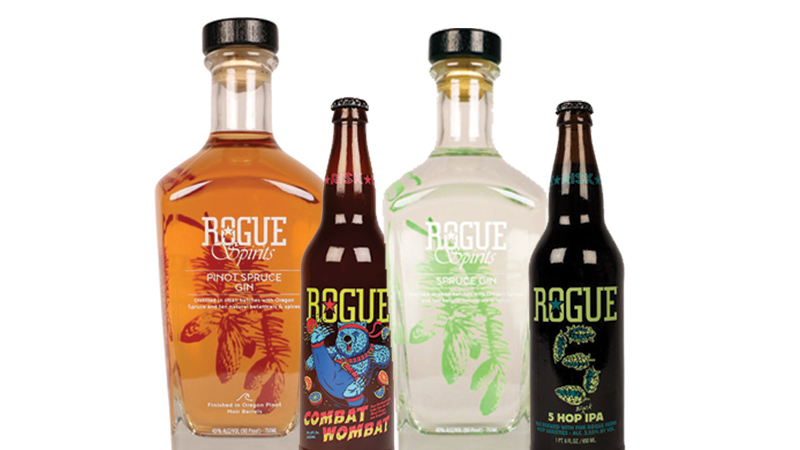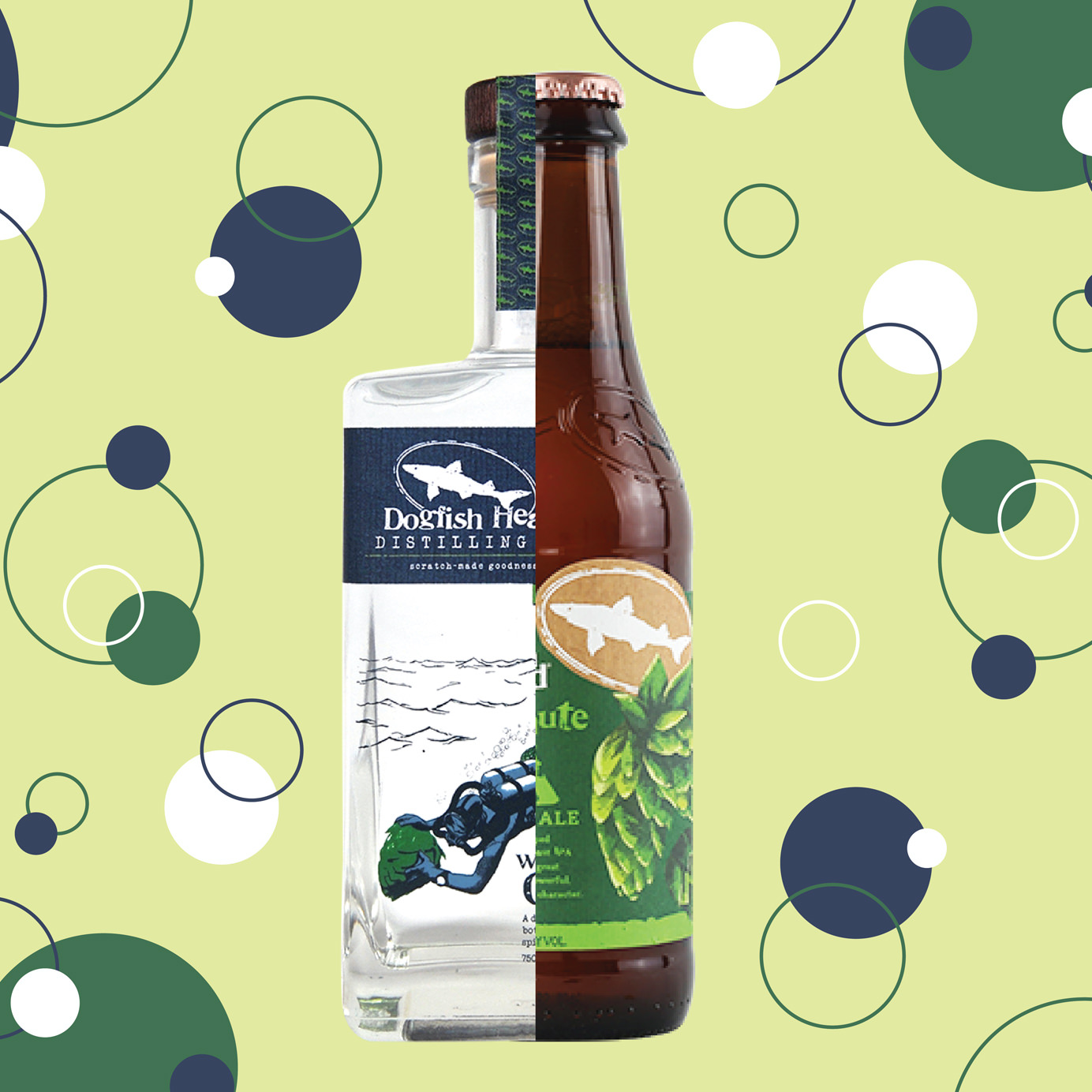Dogfish Head may be one of the more recognizable craft breweries in America, but there was a time when its Rehoboth Beach outfit made it the smallest brewery in the country. After the 90 Minute IPA became a cult favorite, owner Sam Caligione suggested the company “do more,” according to James Montero of Dogfish Head Distilling Co.
And so on the second floor of Dogfish Head Brewings & Eats, the company fashioned a stainless-steel still, where it created off-centered spirits like a peanut butter vodka. In 2014, spirits production moved to the bigger DFH facility in Milton, Del.
“We have the fortune of being afforded the patience to do things the right way,” Montero says. “We focused on three components. One, doing things at the highest level of quality; two, make sure our product was consistent; three, being able to do things in an off-centered, differentiated way.”
Now, hybrid brewery-distilleries are on the rise across the country. From an award-winning spirits offshoot of a winery-turned-brewery on the western shores of Nantucket, to major craft beer players like Dogfish Head and Ballast Point, brewers are embracing the hard stuff.
It’s partially thanks to logistics. More spirits licenses are being awarded to small operators, Montero says, at a rate similar to that of brewery licenses being doled out in the past decade.
Expanding brewing operations to include distillation also makes good business sense. Modern consumers are equal-opportunity drinkers, opting for beer one day, cocktails the next, and maybe some wine with dinner. Gone are the days when beer enthusiasts only drank IPAs or lager — though we do still love those.
It’s not all capitalism and cocktails, though. Breweries like Dogfish Head, Rogue, and Cutwater see spirits production as a way to continue their well-recognized company ethos of innovation. Others, like Nantucket’s Cisco and Mother Earth in North Carolina, view craft distilling as a way to provide a sustainable, local offering to their communities.

Rogue’s spirits lineup currently consists of three whiskeys and two gins — “what we do really well,” says Jake Holshue, who until this past June was in charge of the distillery at Rogue Ales. The botanicals for the gin are grown in-house and Rogue has begun to establish its own cooperage, building its own barrels from Oregon oak.
Rogue uses a method it calls “ocean aging” on its spirits production. Given the company’s proximity to the coast, plus an unusual climate that never gets too hot, yet never freezes, Rogue’s distillers use data logs to compile evidence on things like barometric pressure, and use the nature around them to extrapolate flavor from their barrels.
“We’ve found that high salinity in the air softens the contribution [of the oak in the barrels],” Holshue says. “It’s a unique set of aging conditions that more closely replicate a place like Scotland.”
Rogue’s venture into the spirits world was the brainchild of the late Jack Joyce, who co-founded the company in 1988 after leaving a little-known Oregon shoe company named Nike. While the beers at Rogue have established a place in the iconography of craft beer, Holshue believes that after about 15 years in the spirits industry, Rogue’s spirits lineup is “starting to get its own foothold and tell its own stories.”
Dogfish Head’s Montero echoes the importance of storytelling. “Our goal was to create a distillery with its own identity,” he says. “We want to make sure there’s a story behind each one of our individual brands.”
Dogfish Head’s lineup now includes nine spirits. Montero calls its Analog Vodka a “fantastic vodka for cocktails” and says gin-averse drinkers “shouldn’t be afraid of” its Compelling Gin. (It’s said to make a mean Bloody Mary.) There’s also Sonic Archeology, a bottled cocktail blending DFH’s rum, whiskey, and brandy.
Montero says distribution will “happen at a smart growth rate, with a pretty tight footprint” in the mid-Atlantic region. In the meantime, DFH Distilling recently opened an R&D Distillery in Rehoboth to get back to the off-centered concoctions it made once upon a time in a second-floor still.
“Being a local company, whether it’s a brewery or distillery, it’s important see where stuff is made and meet the people who make it,” Yuseff Cherney, the founder and master distiller of Cutwater Spirits, says.
Cutwater Spirits originally operated out of Ballast Point. In 2007, Cherney took over production and the company grew to a point where Cutwater needed a separate facility. As the concrete was pouring on that property in 2015, Constellation purchased Ballast Point. According to Cherney, it was difficult to “wrap [both brewery and distillery] into one big parcel,” so Cutwater broke off from Ballast Point.
Cutwater currently bottles seven spirits and offers some excellent canned cocktails with the added bonus of national distribution.
The connection to Ballast Point and San Diego is of utmost importance, Cherney says. The distillery serves Ballast Point beer in its tasting room and all its barrels are made available to local breweries and cideries.
“There’s always going to be an association,” Cherney says. “It’s the roots of the business. We talk about it on our tour. It’s a great story to tell.”
Eastern North Carolina’s Mother Earth Brewing is also a product of evolution, according to President Trent Mooring. The “ugliest building” on the block in downtown Kinston turned into the brewery, which turned into purchasing an entire block, and then another. The brewery eventually spawned the Mother Earth Motor Lodge and Mother Earth Spirits.
“It was a natural progression,” Mooring says. “So we leaped into spirits and hospitality. It was the right calling. We had the space. [We started] very small.”
Mother Earth now makes a rum, gin (a staff favorite), and a whiskey. The latter plays a crucial role in Mother Earth’s imperial stout, Silent Night, providing the barrels in which the beer is aged.
Sustainability is key to all arms of Mother Earth’s operations. “We started using found and reclaimed products for the building’s aesthetics,” Mooring says, noting the usage of used blue jeans and soy spray. “And it just kept us looking to see how much we could do to reduce our carbon footprint.”
Amy Gannett, the director of marketing, says the company’s Gold LEED Certification is integral to who Mother Earth is as a brewer, distiller, and hospitality company. “We try to live up to the challenge of the name Mother Earth,” she says. “We don’t plan on changing that. It’s the key to our identity.”
Identity politics are important to craft brewers, particularly as they expand operations to include spirits. Take a two-hour-or-so ferry ride from mainland Massachusetts to Nantucket and you’ll find Cisco Brewers. Originally born as Nantucket Vineyard in the early 1980s, the brewery debuted in 1996. In 2000, it added Triple Eight Spirits, a distillery named for the well from which it blended its spirits.
Triple Eight’s most acclaimed offering is The Notch, a single-malt whiskey that’s accumulated medals in competitions at home and abroad. There’s also a line of flavored vodkas and liqueurs, as well as what the company calls The Storm Series, which consists of a bourbon, rum, and a gin.
In Chicago’s Logan Square, the popular Maplewood Brewery & Distillery crafts whiskeys, ryes, and gin alongside IPAs, milk stouts, and ales. Three hundred or so miles down I-55 in St. Louis, Square One Brewery and Distillery crafts a prolific lineup of spirits in a historic building formerly owned by Anheuser-Busch.
Handcrafted Texas whiskey is available at Ranger Creek Brewing & Distilling in San Antonio. Farther west, Brickway Brewery & Distillery in Omaha is Nebraska’s first distillery since Prohibition. It crafts a single-malt whiskey, bourbon, vodka, and gin. Reno’s The Depot Craft Brewery Distillery serves up corn whiskeys, bourbons, ryes, and more. In Ketchum, Idaho, where Ernest Hemingway spent his final days, Warfield Distillery & Brewery is churning out ales and porters as well as gin and vodka.
*
Lest all this talk of storytelling and feel-good local vibes strikes you as marketing propaganda, consider the origins of craft beer. The industry emerged as a response to the big beer corporations that rendered the United States virtually brewery-less for over a half-century post-Prohibition. They moved brewing operations away from communities and into factories until craft beer provided a correction to that narrative. At last count, there are 6,000-plus craft breweries across the United States.
Hybrid brewer-distillers are the next step in an industry founded on innovation. The same spirit (pun intended) that led Sam Caligione to want to “do more” inspires brewers across the country to try their hands at new projects. Their stories are only just beginning.
